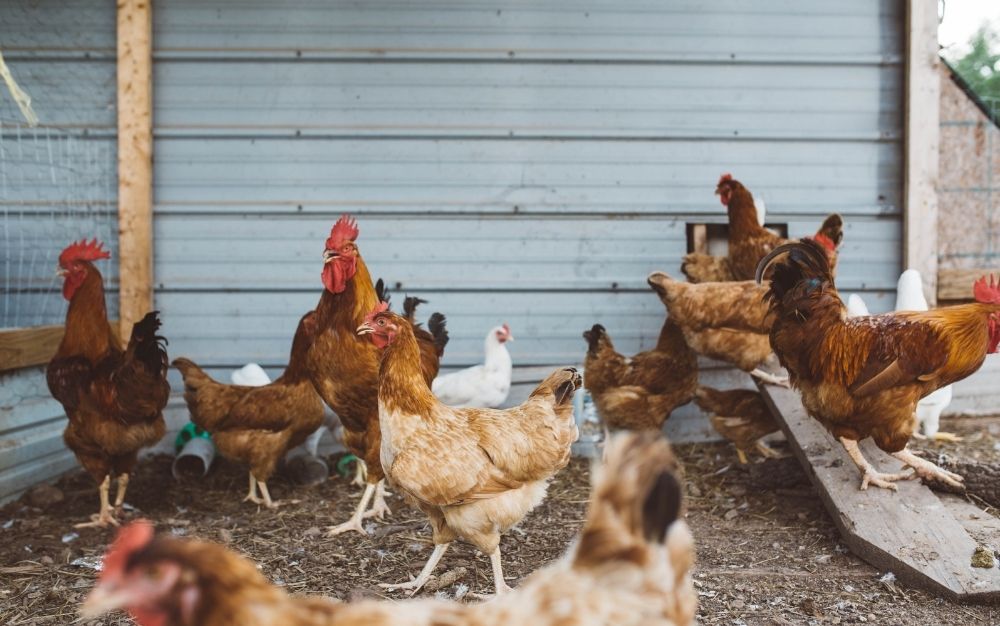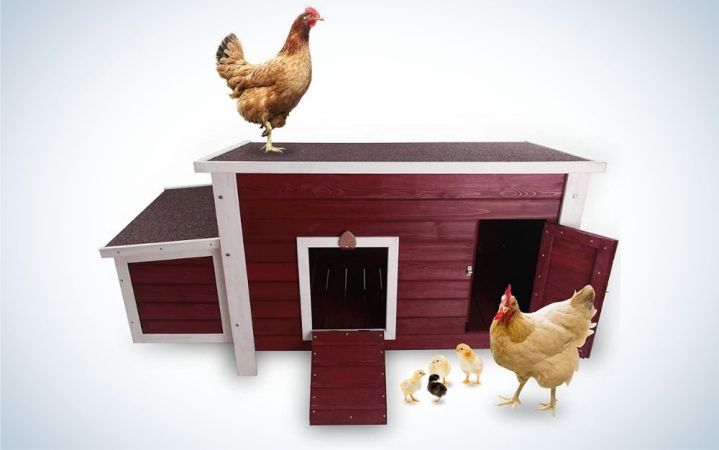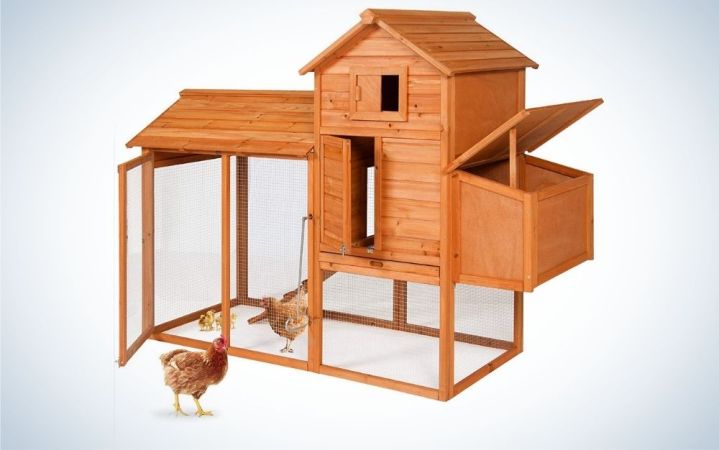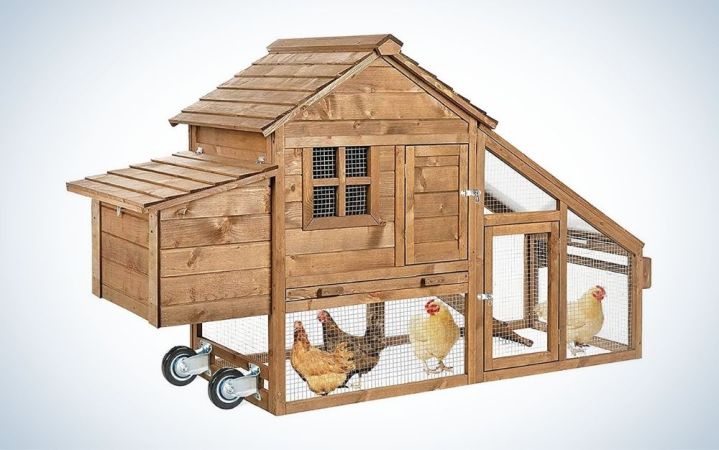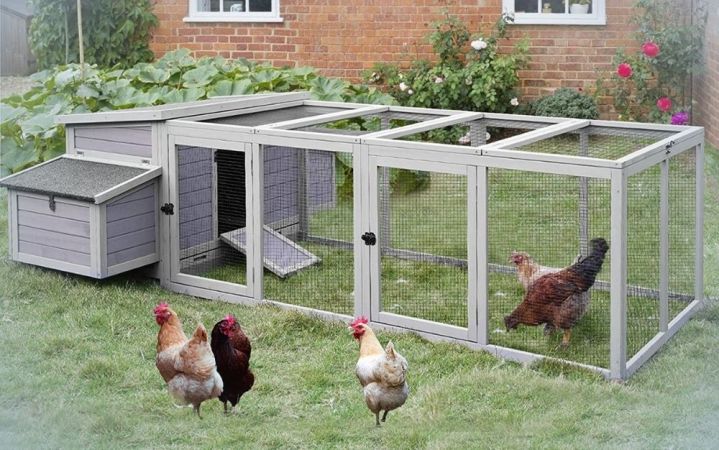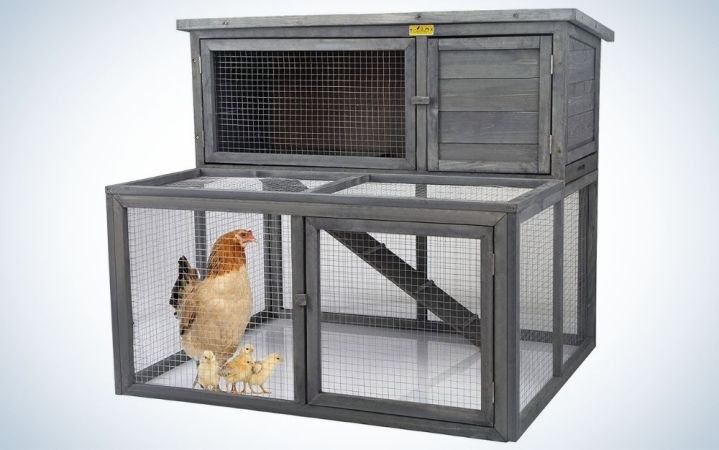We may earn revenue from the products available on this page and participate in affiliate programs. Learn More ›
In recent years, about 8 percent of households in the United States—about 10 million people—kept chickens. And those numbers are soaring, especially when it comes to urban chicken keeping.
It doesn’t matter if you’re a new to raising chickens or already have experience, whether you’re in it for the fresh eggs and meat or simply want a new hobby, the single most important decision is choosing the best chicken coop. The ideal chicken coop for raising backyard chickens balances the need to protect the flock from predators with the birds’ instincts to roam and explore.
- Best Overall: Petsfit Hen House
- Best with a Run: Best Choice Products Hen House
- Best Portable: Portable Chicken Coop
- Best Low Profile: Large Chicken Coop
- Best Budget: Two-Tier Chicken Coop
The Best Chicken Coop for a Healthy Backyard Flock
Thanks to the uptick in interest in raising backyard chickens, new chicken keepers are faced with an overwhelming number of choices when setting up a proper hen house. Selecting the best chicken coop for raising chickens is about balancing chicken biology with the unique needs of urban flocks.
The closest living relatives of domesticated chickens are wild poultry native to the jungles of Southeast Asia. These red junglefowl live in forested areas with naturally thick vegetation—perfect for hiding nests and rich with food sources. During the day, the birds forage for fruit, seeds, grains, insects, and flop around in the dust to “bathe” their oily feathers. At night, they fly up into the trees to roost away from the reach of hungry predators.
Chickens in a backyard flock have the same instincts. The ideal chicken coop provides a secure roosting enclosure to keep the birds safe from predators and gives the flock plenty of space to roam and forage like they would in the wild.
Raising Backyard Chickens: Security
The first consideration for a new backyard flock is safety. Few domesticated chickens have access to the thick plant cover and tall trees that a jungle provides—especially chickens kept in urban or suburban environments. This leaves the flock exposed to a wide array of natural predators, including raccoons, skunks, opossums, and domestic pets like dogs and cats. Chicks and smaller breeds also face danger from the sky in the form of hawks and owls that swoop down to pick up a meal.
Like most birds, chickens don’t see well at night. This makes them especially vulnerable to predators that roam in the dark. In fact, chickens are so vulnerable at night that they belong to a unique group of sleepers that includes some marine mammals and other birds. For these animals, the whole brain never sleeps. Instead, they enjoy unihemispheric sleep where half the brain rests while the other half stays alert for predators.
A safe coop is built from solid material like wood or metal with ventilation provided by small-gauge mesh. The coop should provide at least 2 to 3 feet of space per chicken. Because some predators like raccoons are dexterous, the door should lock securely.
Best Chicken Coop: Petsfit Hen House
Sturdy Construction
The Petsfit hen house is a secure, ventilated enclosure to protect free-ranging hens from predators at night. It includes two nesting boxes with a top hinge for easy access when collecting eggs.
Raising Backyard Chickens: Freedom
It’s not enough to keep chickens locked up, safely protected from predators. Just like their jungle-exploring relatives, domesticated chickens need room to roam and satisfy their natural urge to forage and flop.
Many chicken keepers allow their flock to free range during the day. This gives the birds plenty of open space to forage and explore. Some chicken keepers don’t have the space to offer free ranging. And a flock of free-roaming birds can quickly tear up a small yard space with their scratching and pecking.
A good solution is to set up an enclosed run that gives the chickens enough space to roam while containing their scratching and pecking to a set area. A properly sized run will include 8 to 10 square feet of room for each chicken. It’s important to err on the side of more space when possible since crowding is stressful for the flock and can even lead to pecking injuries and cannibalism.
Best Chicken Coop with a Run: Best Choice Products Hen House
All-In-One Design
The chicken coop includes a secure interior with a pair of nesting boxes plus a fully enclosed run. The removable bottom tray makes it easy to clean out.
Using Tractors for Versatility
Some new chicken keepers aren’t sure where they want to install a chicken coop or run. Others may want the option to adjust the setup with the seasons or changing needs of the yard. This is where chicken tractors come in!
Sadly, these aren’t tractors driven by chickens. They’re enclosed coops or runs designed to move easily from place to place, giving the flock access to different ground areas. This is a great way to try out different spaces for the coop or adjust the chicken setup to accommodate other seasonal needs like pools or fire pits.
The other advantage of a mobile coop or tractor is that it makes it easy to deal with pests. Chicken coops are attractive to vermin like mice and rats, and most chicken keepers struggle with this problem at some point. This can be a particularly pesky issue in urban or suburban environments. Simply moving the coop to deal with signs of a pest problem is a great way to combat this annoying health hazard (and keep the neighbors happy).
Best Portable Chicken Coop: Portable Chicken Coop
Fully Mobile
Not sure where to put the coop? No problem! This portable coop includes a weather-resistant raised hen house plus a secure run—and it’s on wheels, so it’s movable.
The best chicken coop for a backyard flock will simply keep the birds safe and healthy. However, coops that include extras make life for the flock—and the keeper—more comfortable.
Hen House or Hen Palace?
A good chicken coop should provide 8 to 12 inches of elevated space per bird to meet the chickens’ natural urge to roost. In mild climates, these can be bars, branches, or rounded pieces of wood. However, folks keeping chickens in temperatures that get very cold should instead offer flat, wooden roosts. This keeps the chickens’ feet from freezing to the roost and makes it possible for them to fully cover their feet with their feathers as they sleep.
The coop should also include secure nesting boxes for egg-laying hens. These can be ground-level or elevated but should be filled with clean nesting material. Some coops have built-in nesting boxes with hinged tops that make it easy for the keeper to collect eggs from the outside.
For maximum convenience and safety, consider a chicken set up with an automatic coop door. This feature works on a timer to open and close the door right on schedule—even if the chicken keeper is busy.
Best Low Profile Chicken Coop: Large Chicken Coop
One-Level Design
This option has secure nesting areas plus a run—and it’s all one level for a low-profile setup. It includes two removable trays for easy cleaning.
Raising Backyard Chickens on a Budget
While purchasing or constructing a chicken palace is great, chicken keeping doesn’t need to be expensive. It’s simple to build a solid DIY chicken coop using PVC or even scrap wood salvaged from pallets or other projects.
The most important feature of a budget chicken coop is the mesh. Regular chicken wire is simply not safe for chickens since predators can reach through the spaces and pull out birds. It’s important to invest in good quality hardware cloth or small-gauge mesh.
Purchasing a budget coop is another option—especially if the flock can free range during the day. Under those circumstances, a solid hen house that protects the chickens from predators overnight is all you need to meet the flocks’ needs.
Best Budget Chicken Coop: Two-Tier Chicken Coop
Cozy Space
This sturdy two-tier hen house keeps a mother hen and her brood or a pair of hens secure. The hinged roof and pull-out tray make cleaning a simple task.
FAQs:
Do chickens really need a coop?
Chickens need a coop—especially for keepers raising chickens in urban or suburban areas. While wildfowl thrive in dense foliage and tall trees, domesticated chickens need protection from a host of predators, including raccoons, opossums, skunks, dogs, and cats.
How much space do chickens need?
Each chicken needs 2 to 3 square feet of space inside the coop (including 8 to 12 inches of roosting space) and daily access to at least 8 to 10 square feet of space in the form of a run or free ranging.
What should I put on the floor of my chicken coop?
There are tons of options for what to put on the floor of a chicken coop. Many chicken keepers use pine shavings or straw. Some prefer sand for easy scooping or hemp bedding for the deep litter method.
The Best Chicken Coop Keeps Chickens Happy and Healthy
Chicken keepers enjoy a wide range of options to keep chickens at every price point—from simple DIY coop to chicken utopia. The basic needs remain the same: the best chicken coop should keep the birds safe from predators at night and offer them space to roam during the day.
Related: Best Chicken Feed
